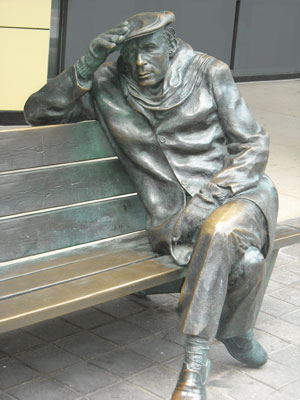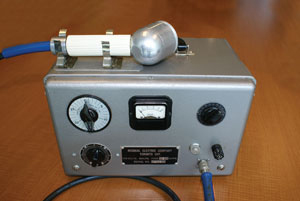
A Canadian Great
He abhorred physical contact, was terrified of germs, hated airplanes
and live audiences and shunned sunlight. He wore heavy sweaters,
scarves, gloves and overcoats even in the hottest weather and crouched
below the keyboard precisely fourteen inches from the floor on a chair
his father built, refusing to use any other his entire life. He
preferred the obscure 17th century English composer Orlando Gibbons to
Mozart and was famously known for cancelling performances at the last
minute when he was the featured soloist. Genius, eccentric,
hypochondriac, recluse, visionary, Glenn Gould was one of the greatest
piano virtuosos of the 20th century and a uniquely Canadian cultural
icon. His radical reinterpretation of classical works shocked and
captivated the world and his exploration of distinctly Canadian themes
enthralled a nation.
Health: Breakfast at Fran’s
Gould’s health concerns, many imaginary, are almost as well known as his eccentricities – and were often related. Gould was the archetypical eccentric genius and an accomplished hypochondriac who avoided physical contact and once sued Steinway when their chief technician slapped his back too emphatically. His fear of flying prevented plane travel, though his near-suicidal driving caused him to skid recklessly over Toronto’s icy winter roads. According to one biographer, Peter Gutman, Gould “gobbled vast amounts of pills in lieu of food”1 and “might have been called anorexic had he not been so plain forgetful about the tedious business of eating”.2 His diet consisted of one meal a day taken between two and three in the morning at Fran’s, a 24-hour diner a block away from his apartment. A vegetarian, he sat at the same booth and invariably ordered the same meal of scrambled eggs.3,4
His posture is a chiropractor’s nightmare. He sits very low at the keyboards — his nose inches from the keyboard — and conducts himself while playing whenever a hand is free.5 Hunched in the “pygmy” chair his father built for him as a child, with his piano raised on wooden blocks so that the keyboard was almost level with his chest and his wrists could be kept absolutely flat, “it was as though the infant prodigy did not dare let himself grow any taller”.6 When the padding wore away, he refused to have it reupholstered and it “became a medieval torture device, with only a single narrow beam running down the middle of the seat from front to back, forcing his entire body weight onto his groin”.7 As he played, Gould vocalised with the music, swaying over the keys with one leg crossed over the other, absorbed in the art of the moment.
 |
| Ruth Abernethy’s bronze Gould in front of the CBC building, Toronto. |
Gould was prescribed an array of drugs, some of which had contradictory actions and their use likely had long term damaging effects on his health.8 Always concerned about various aspects of his health – such as his congenital hypertension – he was especially preoccupied with the safety of his hands.9 Gould’s sedentary habits also militated against exercise, adequate nutrition, sleep and health promotion in general.10 Obsessive about cold, he was famous for appearing at concerts in year round winter wear, meticulous about drafts and indoor temperatures, and would engage in a pre-performance ritual of soaking his hands and arms in near scalding water.11
It has been suggested that Gould had Asperger’s Syndrome, a disorder related to autism. First proposed by a Gould biographer, Dr. Peter Ostwald – and disputed by others – the diagnosis sought to explain Gould’s eccentricities such as his rocking and humming, his isolation and difficulty with social interaction and the extraordinary focus and technical expertise he displayed in his art.12
Whether he suffered circulatory or metabolic problems, Gould’s health worsened over time, due primarily to conflicting prescription drugs administered by a small army of medical practitioners.13 Gould’s early death revealed his own neglect of his well-being. Although health-obsessed, it is unlikely that those issues which most concerned him contributed directly to his death. Rather it was his preoccupation with his various phobias and solitary life of self-inflicted habits that seem most responsible for the stroke that ended his life on October 4, 1982 – nine days after his 50th birthday.14, 15
Gould and His Chiropractors
Gould had a long association with chiropractic. In 1955, he was referred to Dr. Herbert Vear, then in practice on Toronto’s Danforth Avenue, who continued as his primary chiropractor until he was invited to become the Academic Dean at Western States Chiropractic College in 1976. Over the ensuing 20 years Dr. Vear had the opportunity to know Gould well:
“On one occasion shortly before we moved to Portland, Oregon, Gould invited my wife and me into the living room. We had a Hardman Peck piano which Mr. Gould played, and gave a short demonstration of his skill. His only comment was that the keyboard was ‘a bit stiff and needed loosening up’. We still have the piano and my wife still gets pleasure in playing.”
Gould’s various aches, pains, injuries and aliments are well known. Among them was the diagnosis of a compressed nerve in his cervical spine which Gould attributed to the Steinway incident 16. One modality Dr. Vear used to treat Gould’s musculoskeletal complaints was application of ultrasound. When administered over an affected area, the ultrasound generates a deep warmth creating the sensation, in Dr. Vear’s words, of a “mini-massage”. In 1951, Dr. Denny Bennett was the first chiropractor in Ontario to own an ultrasound machine. Dr. Vear became the second, shortly thereafter, when he acquired a Medical Electric Company portable ultrasound unit similar to the one featured in photo B. Apparently, Gould liked Dr. Vear’s ultrasound unit so much, Dr. Vear ordered one for him.
While on holiday, once, Dr. Vear asked Dr. David Drum to take over his patient load which, of course, included Gould. Dr. Drum recalls:
“Glenn had a rotator cuff problem at the time, an injury he attributed to being roughly embraced at Steinway’s in New York City when he was trying out a piano. I had been warned of his aversion to being touched, but the only eccentricity he displayed was phoning and asking me to turn off my office air conditioning two hours before his appointment. It was a sweltering summer day, but I did as requested. Imagine my surprise when he arrived wearing a sweater and promptly shook my hand! He was in the middle of recording the Liszt transcriptions of the Beethoven piano concertos. We hit it off when he found out I had a concert grand piano in my apartment right across the street. This was in l967. After the treatment he insisted on trying out my Heintzman #100,000 which was once played by Liberace. I simply abandoned my patients in the waiting room not wanting to miss the opportunity of a lifetime, and Glenn played my piano for about 40 minutes…said the upper and lower registers were wonderful, but the middle was disappointing. I was thrilled with my private recital and enjoyed all his therapy sessions that summer immensely. I scarcely recall what I did. We talked music. Many years later, I dated the concert pianist, Helena Bowkun, the only graduate of The Royal Conservatory of Music with higher marks than Glenn and she adored him and was deeply wounded as we all were with his premature passing from a cerebral haemorrhage. He was absolutely charming with my patients and never included me in his list of late night chats on the phone.”
 |
| Gould’s Medical Electric Company portable ultrasound unit. |
And the Connection to Us
Shortly after Gould’s death in 1982, Drs. Silvano Mior and Daniel Proctor – then a CMCC clinician and intern respectively – received a call from their personal insurance agent inquiring if they would be interested in acquiring any of the physiotherapeutic instruments contained in an estate he was handling. It transpired, Dr. Mior writes, that “our insurance agent also happened to be the executor of Mr. Gould’s will. We purchased the ultrasound unit because the executor did not want it to fall in the hands of a non-health care worker. After preliminary discussions with the Gould Foundation, we chose to donate the unit to the library.”
And the Medical Electric portable ultrasound unit itself? Since, Dr. Vear tells us, Gould only owned one, CMCC’s Medical Electric portable unit would be the very same one ordered by Dr. Vear for him almost sixty years ago.
Afterlife
Gould’s sudden death stunned the world, but his music and his legacy continue to inspire, challenge and captivate. In a city where Gould’s passing is still recent memory, references to Gould are everywhere. His spirit emanates a presence that is still immediate, fresh and vital almost as though he was here in the room moments ago – and you just missed him. Endlessly self-contradictory, Gould was a hermetic figure who touched the lives of many by the sheer iconoclastic brilliance of his pianism.
If you are one of these, I’d like to hear from you. (szoltai@cmcc.ca) Any light you can shed on Gould’s health concerns, his connection to chiropractic or personal anecdotes that you’d like to share would be appreciated.
Gould’s beloved Steinway CD318 is on display in the lobby of the National Library of Canada. His Medical Electric ultrasound unit is on display in CMCC’s Health Sciences Library.
Glenn Gould: a Canadian Great. •
References
- www.classicalnotes.net/columns/gould.html
- www.bbk.ac.uk/english/skc/gould.htm
- http://en.wikipedia.org/wiki/Glenn_Gould
- http://archives.cbc.ca/arts_entertainment/music/topics/320-1673/
- http://archives.cbc.ca/arts_entertainment/music/topics/320-1673/
- www.bbk.ac.uk/english/skc/gould.htm
- www.classicalnotes.net/columns/gould.html
- Bazzana, Kevin. Wondrous Strange: The Life and Art of Glenn Gould., 2003; p. 330, 355-361.
- Bazzana, Kevin. Wondrous Strange: The Life and Art of Glenn Gould., 2003; p. 356, 420-421.
- Ostwald, Peter. Glenn Gould as Patient. http://www.collections canada.gc.ca/glenngould/028010-502.17-e.html
- www.bbk.ac.uk/english/skc/gould.htm
- http://en.wikipedia.org/wiki/Glenn_Gould
- www.hermitary.com/solitude/gould.html
- www.hermitary.com/solitude/gould.html
- Ostwald, Peter. Glenn Gould as Patient. http://www.collectionscanada.gc.ca/glenngould/028010-502.17-e.html
- Hafner, Katie. A Romance on Three Legs: Glenn Gould’s Obsessive Quest for the Perfect Piano. Bloomsbury, 2008; p. 108.
Print this page